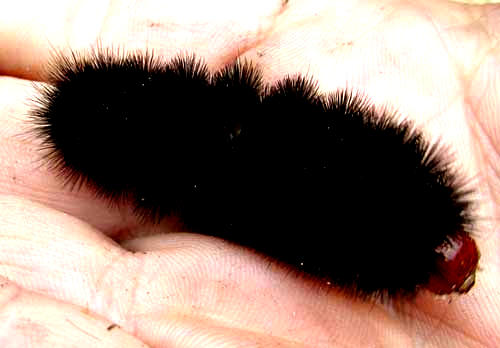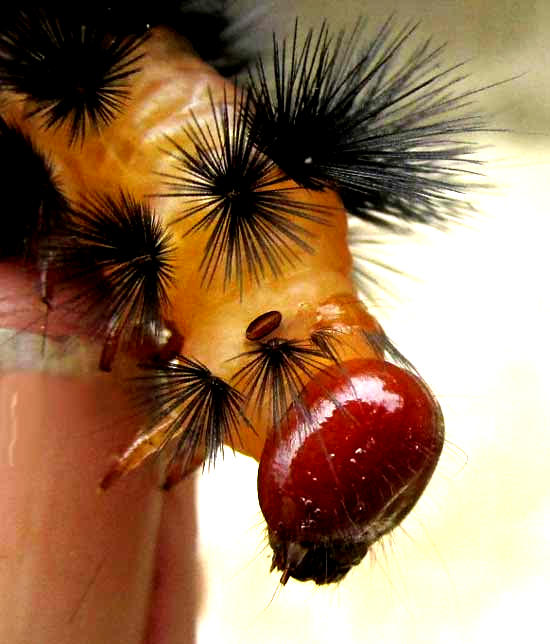Excerpts from Jim Conrad's
Naturalist Newsletter
from the March 13, 2016 Newsletter issued from Hacienda Chichen Resort beside Chichén Itzá Ruins; limestone bedrock; elevation ~39m (~128ft), N20.675°, W88.569°; central Yucatán state, MÉXICO
GIANT WOOLLY BEAR CATERPILLAR
I like to provide habitat information for caterpillars described here, but in this case I hesitate. However, I must be true to form, so I'll tell you that on a recent morning at about 4AM I hiked through the darkness to the Hacienda's bathrooms, chose a stall, dropped my pants, sat down, and there the caterpillar was on my naked leg. I can only guess that during the night he'd taken shelter in my shorts hung beside the mosquito net and that somehow he'd survived my dressing, walking, undressing and sitting. Below, you can see him on my hand once the sun came up:

He's so hairy with stiff, sharp but non-stinging spines that you wonder how he gets around. Of course on his underside he's not hairy at all, as shown below:

The hair clumps spiky nature is better seen below:
<
The above photos went off to volunteer insect identifier Bea in Ontario, who quickly decided that it looked a lot like a Leopard Moth caterpillar, which occurs in the Yucatan. However, Bea also pointed out that pictures on the Internet show vibrant reddish-orange stripes crossing the caterpillar's back, while our individual lacks such marks. But notice in that last picture that right behind the first row of bristles behind the head there's a hint of a dark band, so maybe that's the beginning of a red marking. I suspect that our individual is an immature caterpillar -- one yet to molt into its final " instar." I think Bea got it right again.
So, here we have HYPERCOMPE SCRIBONIA, occurring from southern Ontario and Minnesota south to Florida, Texas, and into Mexico, apparently including the Yucatan Peninsula where collections have been identified as that species. In English the moth producing the caterpillar is known as the Giant Leopard Moth, and the caterpillars themselves sometimes are called Giant Woolly Bears. Full-grown Giant Woolly Bears reach about three inches long (75mm), while ours was only about two inches.
On that page we learn that Giant Woolly Bear caterpillars feed on many plants, including Bougainvillea, citrus species, Poinsettia, and Banana and Avocado trees, all commonly found here at the Hacienda.